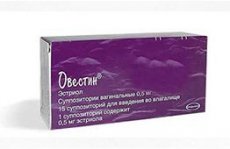Medical expert of the article
New publications
Preparations
Ovestin
Last reviewed: 03.07.2025

All iLive content is medically reviewed or fact checked to ensure as much factual accuracy as possible.
We have strict sourcing guidelines and only link to reputable media sites, academic research institutions and, whenever possible, medically peer reviewed studies. Note that the numbers in parentheses ([1], [2], etc.) are clickable links to these studies.
If you feel that any of our content is inaccurate, out-of-date, or otherwise questionable, please select it and press Ctrl + Enter.

Ovestin is a member of a group of hormonal and antihormonal agents based on natural female sex hormones or their synthetic analogues. ATC code G03CA04; international nonproprietary name – Estriol; manufacturer – Schering-Plough (Germany).
Synonyms: Estriol, Estriol micronized, Estrocad.
Indications Ovestin
Indications for the use of Ovestin are the following pathologies:
- atrophic changes in the vaginal mucosa associated with age-related decrease in estrogen production;
- frequent and painful urination in women during menopause, caused by a decrease in the level of sex hormones;
- infertility due to damage to the endocervical epithelium and insufficient secretion of mucus in the cervix and/or changes in its biochemical composition.
For preventive purposes, Ovestin can be used for urogenital inflammations or after surgery affecting the cervical canal; in some cases, it is used to provide objective data from cytological examination of cervical smears in the diagnosis of diseases of the female reproductive system.
 [ 3 ]
[ 3 ]
Pharmacodynamics
The active ingredient of the drug Ovestin is a natural hormone of the estrogen series, synthesized by the ovaries and the adrenal cortex - estriol. When it is administered to women during menopause, the severity of atrophy of the epithelium of the vagina and lower urinary tract is reduced and their normal microbiological state and the acidity level of the mucous membranes are partially restored.
By increasing the production of cervical secretions and restoring microflora, Ovestin creates favorable conditions for conception and also reduces the sensitivity of the cervical mucosa to extragenital infections.
 [ 7 ]
[ 7 ]
Pharmacokinetics
After oral administration of tablets or topical application of suppositories and cream, Ovestin is almost completely absorbed into the gastrointestinal tract (tablets) or into the vaginal mucosa (suppositories and cream), 90% binding to blood plasma proteins. After oral administration, the highest concentration of estriol in plasma is observed after 60 minutes, after topical use - after 1-2 hours.
Elimination of estriol sulfate conjugates (estriol-16a-glucuronide) occurs within 24 hours after administration, mainly through the kidneys (with urine), with a small amount of the drug excreted in the bile through the intestines.
 [ 8 ]
[ 8 ]
Dosing and administration
Ovestin of any form should be used once a day, the dosage is prescribed by the attending physician depending on the diagnosis. In case of vaginal mucosa atrophy, 4-8 mg of the drug is taken (course of treatment is 30 days); suppository and cream are administered intravaginally at 0.5 mg (at night), the duration of use is determined by the doctor on an individual basis, it is possible to prescribe a maintenance course of therapy using the drug twice a week.
Use Ovestin during pregnancy
Use during pregnancy is strictly contraindicated.
Contraindications
Ovestin is contraindicated in the presence of vaginal bleeding, suspected or confirmed cancer of the mammary glands or endometrium.
The drug is not used by women with a tendency to form blood clots and embolism (blockage) of blood vessels, with acute forms of liver pathologies and porphyria disease.
Side effects Ovestin
The most common side effects of this drug include irritation or burning of the vaginal mucosa (in case of local application); engorgement of the mammary glands and painful sensations in them; swelling of soft tissues; nausea; headache; increased blood pressure; muscle cramps; hyperpigmented spots on the skin.
Overdose
When taking Ovestin orally, an overdose is expressed in an increase in blood pressure, nausea, vomiting and vaginal bleeding. Treatment is symptomatic.
Interactions with other drugs
Ovestin may enhance the effects of steroid drugs and affect the therapeutic effect of adrenolytic and anticoagulant agents.
When used simultaneously with sedatives based on barbituric acid, butadion and rifampicin, the period of elimination of estriol from the body is reduced, and the combination with drugs such as phenytoin, nevirapine and carbamazepine leads to increased biochemical transformation of Ovestin and, accordingly, to a significant decrease in its effectiveness.
Attention!
To simplify the perception of information, this instruction for use of the drug "Ovestin" translated and presented in a special form on the basis of the official instructions for medical use of the drug. Before use read the annotation that came directly to medicines.
Description provided for informational purposes and is not a guide to self-healing. The need for this drug, the purpose of the treatment regimen, methods and dose of the drug is determined solely by the attending physician. Self-medication is dangerous for your health.

